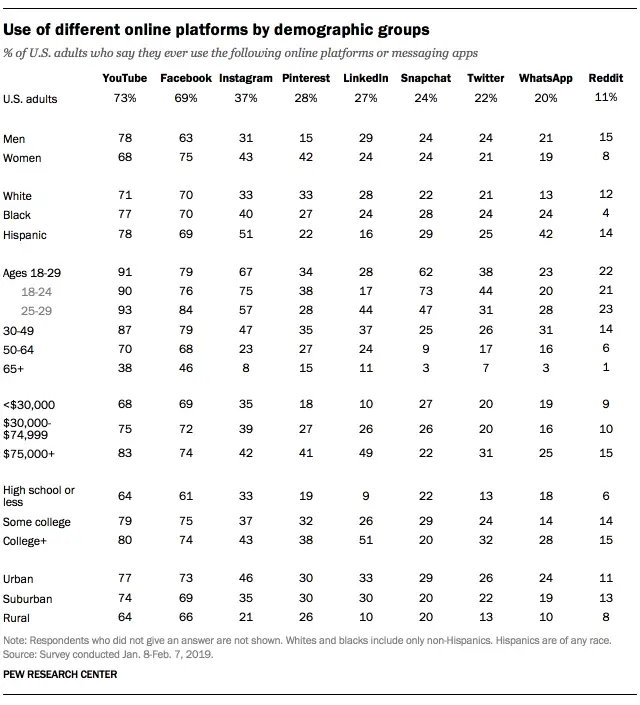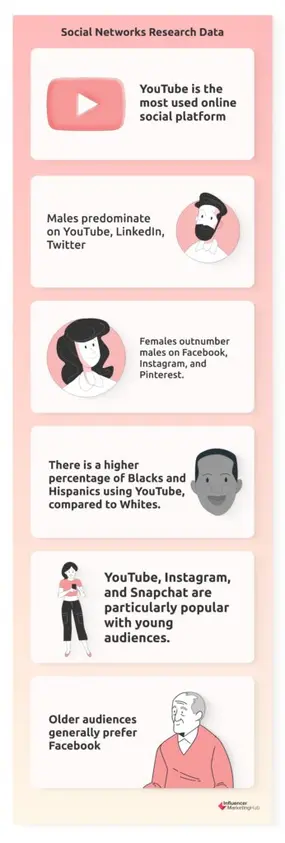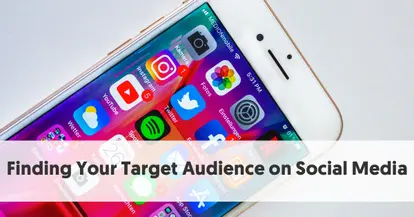Too many businesses run social accounts without any real idea about how they should work. Often, they do so simply because somebody “feels” that it’s the right thing to do. It isn't uncommon for businesses to start social accounts with a rush, and then let them fizzle out to just the occasional post, once disillusionment sets in. The biggest problem that these businesses have is that they make no real effort to find their target audience on social media. They either try to follow everybody they come across, relevant or not, or they simply hope that people go to them and make no effort to build a following.
Yet many businesses perform well on social. Why the difference? What do they do, that their competition doesn't? In many cases, it is that they understand the importance of defining a target audience, and then finding and gently marketing to that target audience (and nobody else) on social media.
Another related problem is that too many firms still see social marketing as being solely to sell goods – just like much traditional marketing. Yet modern audiences hate and resist hard selling techniques. Social marketing is an extension of content marketing – the sharing of relevant information to the "right" group of people. If you do this often enough, these people will begin to take notice of you and start to take an interest in your products. There is little point attempting this, however, if you share content with irrelevant people who will never take an interest in you or your products.
- Who is Your Target Audience?
- Which Social Channels Will Your Target Audience Use?
- Survey Your Existing Customers
- Narrow Your Audience and Search for Clear Niches
- Find and Connect with Your Target Audience
- Create a Custom Audience in Facebook Ads Manager
- Create Content Your Target Audience Will Love
- Frequently Asked Questions
Who is Your Target Audience?
The first stage of any social media marketing campaign is to define your target audience. You certainly can’t search for “them" if you have no idea who "they" are.
If you are lucky, you may already know the types of people to whom you sell your products. Of course, having a general idea and being able to give a tight description of your typical customer are two different propositions.
As you build up a description of your target audience, you will want to ask yourself
- Do you predominantly focus on one of the genders, or do you target both males and females?
- Which age groups are you most hoping to reach? Do you appeal to some generations more than others?
- What types of incomes do your typical customers have? Do you target people with plenty of spare money or people who tend to have money issues?
- What types of values does your target audience have in common?
There are many other demographic and psychographic features that you could go into as you try to picture your target audience. Remember, you are trying to build a picture of your preferred new customers, who will usually match your existing customers unless you are deliberately targeting a different market.
Remember that social marketing mainly involves creating content to share with your target audience. You can't make and share content that will be of interest to everybody. Therefore you need to create the right material for your audience. To do this successfully, you first need to know precisely who makes up your audience.
If you have an existing customer base, it may be well worth your time to create questionnaires for your customers. It’s easy to guess the types of people who buy your products, You will get better results, however, by asking them questions that encourage them to describe themselves – their passion, their interests, the topics about which they would like to learn more.
Which Social Channels Will Your Target Audience Use?
We all know about Facebook, Twitter, Instagram, and YouTube. These are all well-known social and video-sharing sites, with millions of members. And yet, not all people spend their time on these social channels. There are also many other smaller, less visible social networks; in some cases, highly specialized for specific types of audiences.
You can't possibly be active on all of them, and quite frankly, your target audience is unlikely to be either. Even firms that target the most socially active people won't have to target every social channel known to humanity.
Similar types of people tend to stick together. That makes sense. You are more likely to use the same social channels as your friends than you are others.
So as a marketer, your main task is to establish the social sites where your target audience spends their time.

Online platforms by demographic groups
Most of the social network sites offer research on the types of people who use their platform. Pew Research has a fascinating chart giving high-level data on the (US) support base of quite a few of the major social channels. Some of the general conclusions you can make from this data (remember it is US-centric) include:

Social networks research data
- YouTube is the most used online social platform, closely followed by Facebook
- Males predominate on YouTube, LinkedIn, Twitter, WhatsApp, and Reddit. Females outnumber males on Facebook, Instagram, and Pinterest. The numbers are equal for the sexes on SnapChat.
- There is a higher percentage of Blacks and Hispanics using YouTube, compared to Whites. But virtually no difference on Facebook. Hispanics strongly outnumber the other two races on WhatsApp. Very few Blacks use Reddit, yet Hispanics slightly outnumber Whites there.
- YouTube, Instagram, and Snapchat are particularly popular with young audiences. Older audiences generally prefer Facebook, although quite a few watch YouTube. Although the largest group of Pinterest users are aged 18-24, it is also comparatively popular with older audiences.
Survey Your Existing Customers
Assuming that you aren't deliberately trying to change your client base, the best examples of your target audience are your existing customers. While you might already have a good idea of their activities and interests, undoubtedly the best way to gain valuable information is to survey them.
You will want to include questions that will help give you a clear idea of the social sites where they hang out, and the types of content that they like to read. Ask them about their preferred social sites. You could also ask them about whether they read blogs, and if so, what their favorite blog sites are. Similarly, it would be useful to discover their preferred YouTube channels and the types of videos they watch.
You could also include some questions to establish the types of social accounts that your customers are most likely to follow.
Narrow Your Audience and Search for Clear Niches
Combining your pre-existing knowledge, research, and the results of your questionnaires, you should be able to narrow down your target audience to distinct groupings. Not everybody will be the same, but you should be able to put together some groups of people with similar interests and tastes.
You might like to use Facebook Ads Manager to help you with this task. It is excellent for creating narrow niches of people, and you can target using a wide range of demographic data. This will help you estimate the size of the potential sectors you wish to target, ensuring that you don't try and work with a tiny grouping, or one that is unrealistically large.
You will also want to establish who the influencers in your niche are, and in time, make contact with them.
Find and Connect with Your Target Audience
Once you know your target audience, you should make a point of encouraging your existing customers to make contact with you on their preferred social networks. In some cases, such as Facebook Ads Manager, you can upload your current customer database, and Facebook will do its best to find your existing clients on their platform. Quite a few of the social media marketing platforms work with CRMs to help you achieve this.
Create a Custom Audience in Facebook Ads Manager
You can use the Facebook Ads Manager, combined with your customer database, to create a custom audience. Remember that this is just as useful for Instagram as it is for Facebook.
Perhaps even more importantly, once you have created a custom audience representing your existing customers, you can generate look-a-like groups of people who are not yet your customers, but who would make a good fit. These are the people you most want to focus on reaching with your social posts, so they should also be where you target any Facebook or Instagram advertising.
Create Content Your Target Audience Will Love
You may well know your target audience, but that will be of little value to you if you don't do anything to make those people want to take notice of you. You need to create and share the types of content that will interest those people. And remember, that does not mean that you just pitch ads at them.
Ideally, you will target a selection of content at them – a mix of curated content and original content on the topics that interest them. You can throw in the occasional promotion, too.
You need your social pages to be inspirational to these people. You want them to come to your page because they value the content you create and share.
You may have established the types of posts that they like from your surveys. Alternatively, you will need to engage in some trial and error, keeping an eye on your analytics to determine the post types that generally work and the types that don’t seem to engage enthusiasm or interest. Some people will prefer to read blog posts. Others are only interested in funny pictures or short videos. A number might religiously share the motivational quotes you offer. It is an excellent idea to share a variety of post types – but more of those which your followers most love.
Don’t forget to include posts that encourage engagement. Ask questions in your posts, and engage when people leave answers in the comments. If you are making Instagram Stories, remember to include some of the more engaging Stickers.
Whatever you do, don’t be too salesy with your posts. Sure, a small percentage can be promotional, but the vast majority of people who follow you do so because they want value from your posts, not because they want to buy your product.
Frequently Asked Questions
How do I find my target audience with social media?
To find your target audience on social media, follow these easy steps:
- Analyze your offerings and services – and what problems they solve and for who
- Conduct market research with available tools
- Use native audience insight tools on social media platforms
- Create customer profiles and market segments
- Assess the competition
How do you identify the target market audience?
To identify your target market, follow these steps:
- Analyze your offerings and services – and what problems they solve and for who
- Conduct market research
- Create customer profiles and market segments
- Assess the competition
How do you find your target audience on Instagram?
You can find existing demographic insights on Instagram by going to your Instagram analytics. Instagram analytics can tell you a lot about your target audience. Under insights, go to Audience. You can see statistics about your followers, including age, gender, and location.
How do I find my target audience and niche?
Here’s a step-by-step guide to finding your niche and your target audience:
- Identify your target audience’s problems
- Research competition
- Determine profitability
- Validate your idea
- Build a strong foundation




![Create a Powerful Social Media Strategy in 10 Steps [+ Free Template]](https://s.influencermarketinghub.com/imaginary/resize?width=400&height=200&type=webp&url=https://influencermarketinghub.com/wp-content/uploads/2018/11/20-Step-Social-Media-Marketing-Strategy-for-Businesses-in-2022.png)
